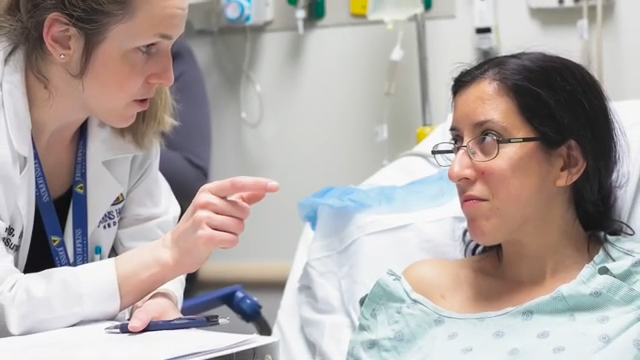HOUSTON, Texas (Ivanhoe Newswire) — Kidney cancer is one of the top ten most common cancers and often leads to surgical removal of that organ. But now, a cutting-edge procedure, that doesn’t use cutting! It removes cancerous and benign tumors in about one hour and the patient is up walking around the next day.
Ryan Anguiano got the scare of his life when he went to the doctor with what he thought was colitis.
“He saw something on my kidney. And, more than likely, 60 percent chance that it was gonna be cancer. And, he needed to take part of my kidney, or my whole kidney out,” Anguiano said.
That’s when Anguiano’s wife stepped in.
Anguiano explained, “My wife says we should probably seek a second opinion before we move forward with this.”
That second opinion saved Anguiano’s kidney.
Justin Muhlenberg, MD, MBA, Interventional Radiologist at M & S Radiology Associates said, “I can perform the ablation and after we’re done I can tell the patient the tumor is gone.”
How does ablation work?
“It’s a needle or a probe that you can insert into a tumor, and you can turn the probe on and it delivers enough heat causing destruction of tissue around the tip of the probe,” Dr. Muhlenberg said.
CT scans and ultrasound imaging help guide the probe, which uses microwave energy to heat the tumor, destroying it. Saline solution keeps it cool.
Dr. Muhlenberg said, “We can slowly guide the needle directly into the tumor, as we turn on the microwave generator, we see that slowly the tissue gets destroyed. What’s going to be left there at the end of the process is just a scar.”
That was a sweet post-op surprise for Anguiano.
“I was sitting there thinking I was all bandaged up and I rolled over and asked, ‘How bad is it,’ and my wife said, ‘You have a band-aid. It looks like a paper cut!” Anguiano told Ivanhoe.com
The only visible sign of Anguiano’s battle with a kidney tumor.
Anguiano was fortunate. His tumor was benign. He’s back to feeling himself and looking forward to walking his daughters down the aisle with both kidneys intact. Dr. Muhlenberg says with new improvements to the technology, interventional radiologists are able to treat larger zones and destroy more abnormal tissue.
Contributors to this news report include: Cyndy McGrath, Supervising Producer; Donna Parker, Field Producer; Bruce Maniscalco, Videographer; Roque Correa, Editor.
To receive a free weekly e-mail on Medical Breakthroughs from Ivanhoe, sign up at: http://www.ivanhoe.com/ftk
MEDICAL BREAKTHROUGHS
RESEARCH SUMMARY
TOPIC: ABLATION SAVES RYAN’S KIDNEY
REPORT: MB #4600
BACKGROUND: Kidney and liver cancer start when cells in the body begin to grow out of control. There are four types of kidney cancer: renal cell carcinoma, transitional cell carcinoma, nephroblastoma, and renal sarcoma. Liver cancer also has four primary cancers that start in the liver: hepatocellular carcinoma (HCC), intrahepatic cholangiocarcinoma, angiosarcoma, and hemangiosarcoma. Resecting tumors from patients with liver or kidney cancer has been a long process involving surgical removal of the tumor. These surgeries can be long and have a recovery period that is not always easy for patients.
(Source: https://www.cancer.org/cancer/kidney-cancer/about/what-is-kidney-cancer.html & https://www.cancer.org/cancer/liver-cancer/about/what-is-liver-cancer.html)
TREATMENT: The type of treatment for these two cancers depends on the severity of the cancer. The number one treatment for both is surgery. For the liver, surgeons will either try and remove the tumor and a small portion of healthy liver tissue if the tumor is small enough. Or, they will have to perform a liver transplant which is not an option for many patients. There are other treatments like radiation therapy, immunotherapy, chemotherapy, and targeted drug therapy. For kidney cancer you have three forms of surgery. Radical nephrectomy is the full removal of the tumor, the entire kidney, as well as some surrounding tissue. If the tumor is smaller the surgeon will perform a partial nephrectomy which is just the removal of the tumor. The last is laparoscopic and robotic surgery which is a longer but less painful procedure and can be done to remove the kidney as well as to perform a partial nephrectomy.
(Sources: https://www.mayoclinic.org/diseases-conditions/liver-cancer/diagnosis-treatment/drc-20353664 & https://www.cancer.net/cancer-types/kidney-cancer/types-treatment)
MICROWAVE ABLATION: Microwave ablation is a fairly new procedure that was introduced in the last 20 years. Justin Muhlenberg, MD, MBA, Interventional Radiologist at M & S Radiology Associates, explained how it works, “In clinical practice, what it really is, is a needle or a probe that you can insert into a tumor and you can turn the probe on and it delivers enough heat to cause destruction of tissue surrounding the tip of the probe in a spherical or conical shape, so that you can destroy the tumor in a room of normal healthy tissue around it.” He said the surgery is only an hour long and the recovery time is much quicker. The technology is only continuing to advance. Surgeons can now remove cancers in the lung as well and are continuing to expand, “The newest part of the technology is the fact that they are improving upon these devices so that we can get larger zones of ablation, which means we can destroy more tissue, which means we can offer more patients the treatment,” said Dr. Muhlenberg.
(Source: Justin Muhlenberg, MD, MBA)
FOR MORE INFORMATION ON THIS REPORT, PLEASE CONTACT:
Laura Radocaj, PR
772-643-3666
If this story or any other Ivanhoe story has impacted your life or prompted you or someone you know to seek or change treatments, please let us know by contacting Marjorie Bekaert Thomas at mthomas@ivanhoe.com




